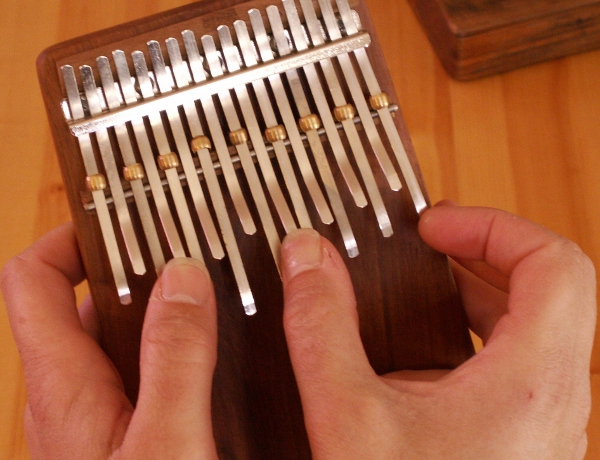These two-note chords can be played by the right hand. The main reason to play entirely with the right hand is that this frees up the left hand to dance on that pentatonic scale.
In order to play these two notes with the right hand, play the left note with your right thumb and the right note with your right index finger. The thumb will pluck down, and the right index finger will actually come from under the tine and it will pluck upward.
(By the way, this is the mbira right-finger technique. Usually on karimba, the right index finger is playing the upper row tines, and comes from above and plucks downward.)
Your important homework:
Those squiggles are quarter rests. Play two chords with the right hand, then lay off (or rest) for two beats, change notes a bit and repeat. Once you get good and steady with the right hand, start inserting a note or three on the left side. You have already practiced some left thumb riffs on the pentatonic scale – feel free to dig through those riffs for some ideas to play around with. Or just invent something from out of the blue on the left side. For now, don’t overlap the right and left thumb parts, but let the left thumb part answer the right thumb part. You could stay in time (ie, spending the same amount of time on the right thumb part as the left thumb part), or you could step out of time, play the two right thumb chords, then answer with a stretched-out call from the left side. Let the left say as much as it wants; it has probably spent much of its life oppressed by the tyranny of the right, and this is an opportunity for the left to strengthen, increase its skill, and heal from that oppression.
I could write a master’s thesis on that – but instead, why don’t you explore it a bit?
You can do this exercise every day, and do it differently every day.
This exercise fulfills the promise of this series: the right thumb plays something low, strong, and supportive while the left thumb plays a dancing melody.
This is practice for the supportive part the right thumb will play.



Sign up for our newsletter and free resources with your email address:
We pinky promise not to spam you and to only send good stuff.
 Christmas in July 2025
Christmas in July 2025 Patriotic and American Music for Kalimba
Patriotic and American Music for Kalimba